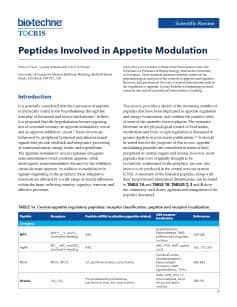GPR83
GPR83 is a member of the Class A receptor family of heterotrimeric G protein-coupled receptors and belongs to the NPY peptide receptor family. Formally an orphan receptor, GPR83 is now known to bind PEN, an endogenous neuropeptide.
GPR83 Agonists |
|
|---|---|
| Cat. No. | Product Name / Activity |
| 6308 | PEN (mouse) |
| GPR83 agonist | |
GPR83, encoded by the GPR83 gene, is a member of the Class A orphan receptor family of heterotrimeric G-protein coupled receptors and belongs to the NPY peptide receptor family. Formally an orphan receptor, GPR83 is now known to bind the endogenous proSAAS peptide PEN, an orexigenic neuropeptide.
GPR83 shows high abundance in the brain, particularly in the areas that regulates energy metabolism, including the amygdala, hypothalamus and brainstem. Expression of both GPR83 and PEN has also been identified in peripheral tissues including the kidneys, liver and spleen. GPR83 knockout mice show reduced stress envoked anxiety, delayed spatial learning and are resisitant to obesity when fed a high fat diet, suggesting GPR83 has a role in learning and memory as well as feeding regulation.
PEN binding to GPR83 leads to Gq mediated activation of phospholipase C as well as Gi mediated inhibition of adenylyl cyclase and cAMP production, suggesting GPR83 may regulate intracellular signaling pathways in various ways.
GPR83 is known to interact with other receptors, including GPR171, the receptor for bigLEN, another proSAAS peptide. Colocalization and interaction of their intracellular signaling pathways suggest GPR83 and GPR171 may be functionally coupled in the regulation of feeding and body weight.
External sources of pharmacological information for GPR83 :
Literature for GPR83
Tocris offers the following scientific literature for GPR83 to showcase our products. We invite you to request* your copy today!
*Please note that Tocris will only send literature to established scientific business / institute addresses.
Peptides Involved in Appetite Modulation Scientific Review
Written by Sonia Tucci, Lynsay Kobelis and Tim Kirkham, this review provides a synopsis of the increasing number of peptides that have been implicated in appetite regulation and energy homeostasis; putative roles of the major peptides are outlined and compounds available from Tocris are listed.

